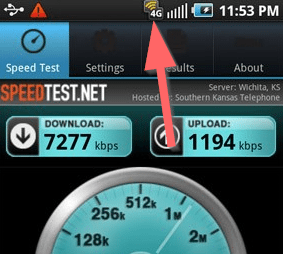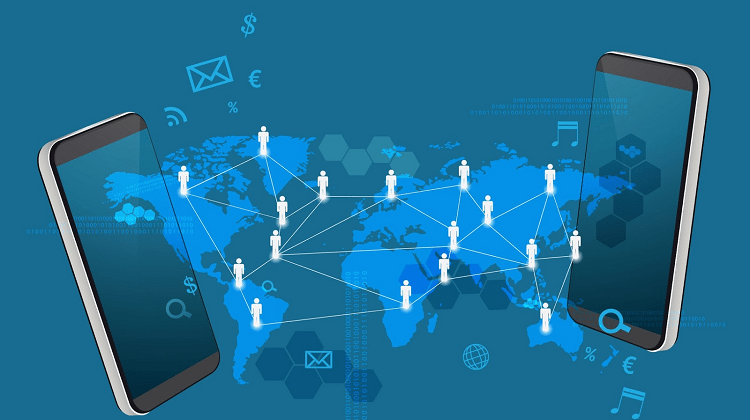A significant percentage of smartphone users also have mobile internet. However, the mobile network names are a mess. Yes, the 4G mobile network makes intuitive sense that it is faster than 3G. But where do E, H, H+, and others fit in? In this guide, we will take you through the mobile internet generations, from the early 2G to the current fastest 4G mobile network, as well as the upcoming 5G.
Unblock any international website, browse anonymously, and download movies and Mp3 with complete safety with CyberGhost, just for $2.75 per month:
The many types of mobile networks
If you look at the upper right corner of your smartphone - or the left, in some phones - you can see your mobile Internet coverage. In most cases, it is right next to the signal strength, where you will see an alphanumeric code on your notification bar.

For more on signal strength and cell phone radiation or how it can affect our health, check out our guide.
In this guide, we will analyze all these alphanumeric codes, and we will explain how speed limits increased, starting from the slowest (2G mobile network) and working up to the current fastest tier (4G mobile network).
You should note that beyond our device's and our carrier's capabilities, the highest mobile network we can connect with also depends on external factors. These can be the distance from a cell tower, whether we live in a major city or a remote area, and so on.
A device that supports the 4G mobile network might connect with a 3G bandwidth or lower in areas with low signal. Even relatively simple factors can affect the signal strength, such as being indoors or having bad weather in our area.
1G
Before we start with 2G, which refers to digital telecommunications, we think that it is worth mentioning the first generation of wireless telephone technology: 1G.

The name by itself marks the generation, and it made its first appearance in the 1980s.
1G is an analog mobile telecommunication standard, and that is the main difference from its successors, which encode the voice to digital signals. That means we will never see the "1G" mark on our smartphone's notification bar.
2G
2G arrived in 1991 and brought several advantages compared to its predecessor. It introduced data services like SMS and MMS, which became rather popular during the first years of their development.

Regarding speed, 2G with the GSM standard can reach up to 14.4 Kbps, which is extremely slow for our current standards. In fact, in many parts of North America and Europe, we won't find 2G networks at all.
G
The letter "G" marks the GPRS mobile data service, which is short for General Packet Radio Service. GPRS became widely used in 2000, and it is considered as the "two and a half" generation of mobile internet. Thus it earned the nickname 2.5G.

GPRS was critical in the evolution of mobile networks, and it opened the way for the development of 3G.
Its maximum speed is at 54 Kbps, and it is still in use. In fact, it is the slowest speed we may encounter today. We don't recommend you to browse the Internet with such a speed, except if you have a lot of free time to waste.
E
Some of you may have heard of EDGE network (Enhanced Data rates for GSM Evolution). EDGE is an improved version of GPRS that allows higher data transmission rates.
It was deployed in 2003, and it offered a vast improvement on the Internet speed, almost three times faster than the previous network. That earned it the name "2.75G" since it is close to the third generation.
EDGE's maximum speed is at 236 Kbps, and we will see it with the letter "E" on our portable devices.

Even with 236 Kbps though, it is tough to browse the Internet smoothly or watch a video on YouTube without the need to throw your device out of the window.
3G
You may have realized by now that 3G stands for the third generation of wireless mobile network.

The first 3G networks appeared in 1998, although 3G mobile internet became commercially available in 2001. At a maximum speed of 384 Kbps, browsing not only became tolerable, but we could stream music and videos from our phones.
3G is probably the most well-known internet network, although the third generation has evolved even more with the services we'll mention below.
H
Moving onto 3.5G, we have HSPA (High-Speed Packet Access) and the letter "H" next to our signal bar.

HSPA is part of two mobile protocols, HSDPA and HSUPA. It extended the performance of existing 3G networks.
That means we can have a maximum speed of 14.4 Mbps, which is a rather impressive jump from the previews speeds. With HSPA we can browse the Internet with ease, watch videos, or stream media without any problems.
H+
The H+ symbol means you have a further improved HSPA network, known as HSPA+ or Evolved High-Speed Packet Access.

This protocol was released in 2008, but it became available worldwide in 2010. If you 're wondering about the speed, HSPA+ has a maximum download speed of 168 Mbps and 22 Mbps for upload at its final release standard (Release 10).
Of course, these rates refer to ideal signal conditions, which is never the case. Still, H+ is one of the fastest networks you may encounter. The 4G mobile network is still limited in some countries, pending carrier and infrastructure support.
4G mobile network
In 2009, the fourth generation came into play with the first release standard, known as LTE (Long Term Evolution). Nowadays, many countries use 4G mobile network.

As opposed to earlier generations, the 4G mobile network supports an all-Internet Protocol-based communication system, such as IP Telephony. All 4G systems have abandoned the spread spectrum radio technology used in 3G and made it possible to transfer very high bit rates.
4G mobile network standards continue to evolve, and 4G's maximum speed can reach up to 1 Gbps with LTE-AProtocol-based. If you have the 4G mark on your signal bar, you're lucky enough to have the highest speeds possible as of yet.
5G
As we've seen up until now, since the first move from analog 1G (1981) to digital 2G in 1992, approximately every ten years, we have a new generation of mobile network.
3G became widely available in 2001, and 4G mobile network, although developed in 2008, it showed its real capabilities around 2012.

A generation refers to a change in fundamental nature of the service, higher peak bit rates, wider channel frequency bandwidth, and so on. The next telecommunications standards beyond 4G mobile network are 5G, but it is still under development.
5G will provide even faster speeds and it should be able to take the Internet of Things to a new level.
We should clarify that 5G is NOT available yet. Some companies promise "5G speeds", such as AT&T's 5G Evolution network, which is a brand for Gigabit LTE. Gigabit LTE is the latest advancement in 4G LTE but is certainly not 5G.
Summary
All these may sound a bit confusing at first, generations, networks, speeds, etc. What kind of network do I have after all?
We have summed it all up in the following matrix.

The speeds refer to maximum theoretical values derived from different standards for ideal scenarios. You should have in mind that in the real world the speeds will be lower, due to throttling by the operator, quality of service, network congestion, etc.
Do you have access to a 4G mobile network?
How about you? Do you live in an area with 4G coverage, or you have to rely on 3G for you data transfers? Do you have any questions about the networks mentioned above?
You can share your experience in the comments below.
Support PCsteps
Do you want to support PCsteps, so we can post high quality articles throughout the week?
You can like our Facebook page, share this post with your friends, and select our affiliate links for your purchases on Amazon.com or Newegg.
If you prefer your purchases from China, we are affiliated with the largest international e-shops:





Can anyone explain why my Tesco/O2 E & 4G work (obviously the 4G is faster) yet my H+ never seemingly downloads a single byte?